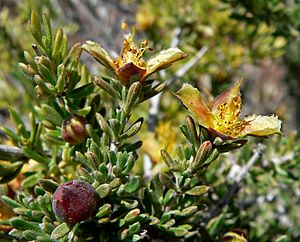Coleogyne facts for kids
Quick facts for kids Coleogyne |
|
|---|---|
 |
|
| Scientific classification | |
| Genus: |
Coleogyne
|
| Species: |
ramosissima
|
Coleogyne ramosissima is a type of plant commonly known as blackbrush. It is a small, spiky shrub that grows in the deserts of the southwestern United States. This plant is often dark gray-green and has a unique smell. It's called blackbrush because its gray branches turn darker when wet from rain.
Blackbrush belongs to the rose family (called Rosaceae). It is the only species in its group, or genus, which is named Coleogyne. This means it's quite special!
Contents
What Blackbrush Looks Like
Blackbrush plants have many dense, tangled branches. The scientific name "ramosissima" actually means "many branched." These branches often end in sharp, spiny tips.
This plant can cover large areas of the desert floor and hillsides. When you see a lot of blackbrush together, it makes the landscape look a uniform dark-gray color. Areas where blackbrush is the main plant are sometimes called "blackbrush scrub."
When there is a lot of dryness, like a drought, blackbrush drops most of its leaves. It becomes dormant, which means it rests. However, it usually keeps some leaves at the ends of its branches. These thick, branched plants can form dense clumps that spread across the ground. They can also grow upright, reaching about six feet tall in the Mojave Desert and four feet tall in the Canyonlands desert region.
Blackbrush Flowers
Blackbrush flowers are a bit unusual for the rose family. They have four yellowish sepals, which are like small leaves that protect the flower bud. Most rose family flowers have five sepals. Blackbrush flowers also have many yellow stamens, which produce pollen.
Unlike most flowers in the rose family, blackbrush flowers do not have petals. The sepals often stay on the plant even after the flower opens. They surround the whiskery stamens and the central pistil, which is the part that makes seeds.
Blackbrush flowers usually appear between April and July. For this desert plant, a heavy spring rain often triggers the flowering process. The tough, leathery flowers grow at the ends of small stems. They are covered by thick, fuzzy sepals that are yellow inside and reddish or orange on the outside.
Blackbrush Leaves
The leaves of the blackbrush are small, usually less than half an inch long. They are shaped like a spear, wider at the tip and narrower at the base. Each leaf has a tiny point at its tip.
One interesting thing about blackbrush leaves is how they grow. They are arranged in opposite pairs along the stem. This is uncommon for plants in the rose family, where leaves usually grow one at a time along the stem.
Where Blackbrush Grows
Blackbrush forms large plant communities in the Canyonlands region and the Mojave Desert.
How Blackbrush Reproduces
After flowering, the plant produces a small fruit called an achene, which is only a few millimeters long. Blackbrush can reproduce from seeds, but this happens very rarely. The seeds don't spread easily, and not many seedlings survive. This plant needs a very specific range of temperature and moisture to reproduce successfully. Because of this, new plants don't appear very often. However, the blackbrush plants themselves are very tough and can live for a long time.
Images for kids
See also



